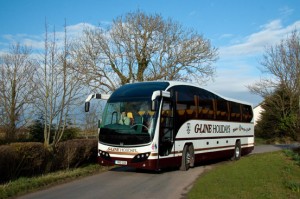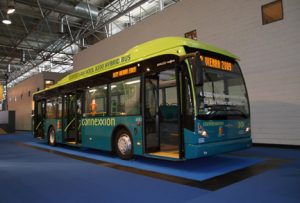By Doug Jack
Every two years I carry out much of the research and write a large part of a report which has become an industry standard; the latest edition of “The World Bus & Coach Manufacturing Industry” report is due to be published in June. As part of this exercise the chief executives of the top six European manufacturers kindly agreed to be interviewed.
In a typical year, registration of buses and coaches above 8.0 tons gross in Western Europe make up only around 10 percent of the global market. Nonetheless, European manufacturers have a large amount of influence on global markets through overseas subsidiaries, joint ventures, licensing agreements, assembly operations and partnerships with selected bodybuilders.
Demand for transit buses remained remarkably strong. This is partly due to longer order lead times, but also because some European governments introduced stimulus programs to keep factories busy and retain their skilled workforces. Overall, in 2009 the decline was marginal compared with the previous year.
Global financial crisis
Because the global financial crisis created such uncertainty, it was a different story with interurban, charter and scheduled coaches. Registrations of new vehicles fell by up to 25 percent compared with the previous year. Many smaller family operations decided to keep their existing vehicles for another year.
Get more great articles like this one with a subscription to BusRide!
Click here to subscribe.
As interest rates plummeted to all time lows, the extended coach tour business within Europe grew more concerned that the global crisis would hold back numbers of inbound tourists, particularly from North America and the far East.
Five out of the six top European manufacturers are vertically integrated. Their bus and coach operations are connected to much larger truck operations. When the financial crisis hit the truck markets, the bus divisions noticed quite a change.
Previously they had always been a lower priority to the engine factories, demanding comparatively low volumes of quite different units. Perhaps the best example is the horizontal engines that are still used in some models by MAN and Mercedes-Benz.
Suddenly, the engine factories could not do enough to help the “little brothers” who were still taking nearly the same volumes for their buses and coaches.
VDL Bus & Coach, based in the Netherlands, relies heavily on DAF for engines and axles. The latter company is a wholly-owned subsidiary of Paccar and has an excellent reputation for durable and economical engines.
Independent driveline suppliers
The second tier of European bus and coachbuilders rely heavily on independent driveline suppliers. Cummins has a very strong position because of its wide power range, but Iveco, MAN and Mercedes-Benz also serve this sector to some degree or other. They tend to pick customers who are not competing with their own complete vehicles, because it would be a folly to sell just an engine at the expense of a complete bus or coach.
Because the top five European builders are directly connected to large truck operations, they can benefit from very comprehensive parts and service networks. Most of the truck companies will nominate about one in 8-10 of their dealers to be specialist bus and coach service outlets, with a stock of bus parts and workshop staff who are trained in their maintenance. It means that a customer is never far from a service outlet. This is particularly reassuring to coach companies who may travel across a continent which is no larger than the U.S., but with many different languages.
Coach companies are relying more and more on these specialist dealers for service. A small company cannot justify investment in expensive electronic diagnostic equipment. It makes more sense to have vehicles serviced and repaired overnight, maximizing their opportunity to earn revenue.
Manufacturers in Europe are steadily moving towards complete integral vehicles, built wholly in one factory. Customers like that, because there is one badge on the front, and therefore one company responsible for any problems and for the provision of parts and service.
Separate chassis and bodywork
The concept of separate chassis and bodywork still prevails in a number of markets but it is slowly and steadily coming under threat. Van Hool can still build luxury coachwork on chassis. It was once a large part of their business, but in recent years has become minimal, mainly for the United Kingdom, Ireland and, sometimes, Sweden. Even Irizar, the largest builder of interurban and luxury coachwork on chassis in Europe, has seen the way that the markets are turning and launched its own integral coaches last year. They are now going through extensive test programs.
The European Union has set tough targets to reduce carbon emissions by 2020. In most countries, cars, multi-purpose vehicles and sports utility vehicles, which are less fuel efficient, have to pay higher taxes to circulate. Many people will be reluctant to give up their cars completely but will have to become more selective about what they purchase.
The concern about emissions can only be good news for the bus and coach industry. The carbon footprint per passenger per mile is already exceptionally low. It is a statistic that can already be sold to the mainly younger generations who are likely, in their dotage, to regret how profligate their parents and grandparents were with fossil fuels.
Compressed natural gas (CNG) has been around as an alternative fuel for many years but nowadays offers little improvement over the latest Euro 5 and EPA 10 engines at the tailpipe. However, CNG-powered buses are still politically popular. They are often painted in green and blue colors and proclaim that they are environmentally friendly. When did anyone last see the same type of promotion on an all-diesel bus? Furthermore, natural gas is also a fossil fuel.
Hybrid buses are also on the European agenda but in much lower volumes than on your side of the Atlantic. It is a strange equation; on the one hand, your fleets are eligible for very high percentages of government funding, which is not available in Europe. On the other hand, our costs of diesel fuel are generally much higher; therefore the payback period ought to be quicker.
The crucial question in Europe is that operators do not know the operating cost per mile for running hybrid buses. This is most important when they are bidding to operate tendered services.
The two favored systems for storing electrical energy are banks of lithium ion batteries or super capacitors. The latter ought to last the lifetime of a vehicle. The battery manufacturers are starting to talk about offering their products on a contract basis, paying for each mile of use, similar to tire contracts. That takes out some of the risk but it can also have a major impact on residual value at the end of a vehicle’s life with its first owner.
There is also growing interest in alternative fuels, ranging from bio-diesel to biomass. There has been concern about growing crops to produce biofuels, because that might lead to higher basic food prices in the developing countries. We now seem to be moving on to second and third generation of biofuels which can be produced on land unsuitable for arable crops and which use plants that are inedible.
Do you like this article? Subscribe TODAY to get
BusRide now available in digital!
In the Scandinavian countries, there is also keen interest in biomass. I apologize if you are devouring BUSRide over breakfast but Oslo, the capital of Norway, previously considered sewage and surplus food from hotels and restaurants as a waste disposal problem. Within a year or two more than 150 buses in the city will be running on gas produced from these sources, saving the city considerable costs and benefiting from very low emissions.
Doug Jack is with Transport Resources in the United Kingdom.



